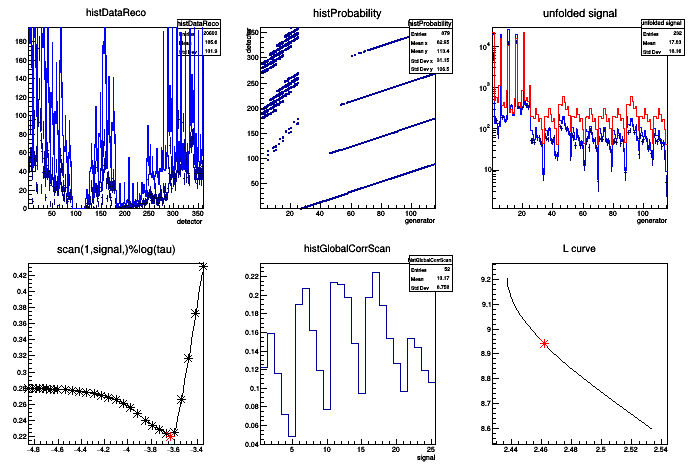#include <iostream>
#include <cmath>
#include <map>
void testUnfold5d()
{
TFile *outputFile=
new TFile(
"testUnfold5_results.root",
"recreate");
TFile *inputFile=
new TFile(
"testUnfold5_histograms.root");
inputFile->
GetObject(
"detector",detectorBinning);
inputFile->
GetObject(
"generator",generatorBinning);
if((!detectorBinning)||(!generatorBinning)) {
cout<<"problem to read binning schemes\n";
}
detectorBinning->
Write();
generatorBinning->
Write();
TH1 *histDataReco,*histDataTruth;
inputFile->
GetObject(
"histDataReco",histDataReco);
inputFile->
GetObject(
"histDataTruth",histDataTruth);
inputFile->
GetObject(
"histMCGenRec",histMCGenRec);
if((!histDataReco)||(!histDataTruth)||(!histMCGenRec)) {
cout<<"problem to read input histograms\n";
}
const char *REGULARISATION_DISTRIBUTION=0;
const char *REGULARISATION_AXISSTEERING="*[B]";
regMode,constraintMode,densityFlags,
generatorBinning,detectorBinning,
REGULARISATION_DISTRIBUTION,
REGULARISATION_AXISSTEERING);
unfold.SetInput(histDataReco );
#ifdef PRINT_MATRIX_L
TH2 *histL= unfold.GetL(
"L");
cout<<"L["<<unfold.GetLBinning()->GetBinName(j)<<"]";
if(c!=0.0) cout<<
" ["<<i<<
"]="<<
c;
}
cout<<"\n";
}
#endif
const char *SCAN_DISTRIBUTION="signal";
const char *SCAN_AXISSTEERING=0;
Int_t iBest=unfold.ScanTau(nScan,0.,0.,&rhoLogTau,
SCAN_DISTRIBUTION,SCAN_AXISSTEERING,
&lCurve);
rhoLogTau->
GetKnot(iBest,t[0],rho[0]);
for(
Int_t i=0;i<nScan;i++) {
rhoLogTau->
GetKnot(i,tAll[i],rhoAll[i]);
}
cout<<"chi**2="<<unfold.GetChi2A()<<"+"<<unfold.GetChi2L()
<<" / "<<unfold.GetNdf()<<"\n";
TH1 *histDataUnfold=unfold.GetOutput(
"unfolded signal",0,0,0,
kFALSE);
histMCReco->
Scale(scaleFactor);
histMCTruth->
Scale(scaleFactor);
TH2 *histProbability=unfold.GetProbabilityMatrix(
"histProbability");
TH1 *histGlobalCorr=unfold.GetRhoItotal(
"histGlobalCorr",0,0,0,
kFALSE);
TH1 *histGlobalCorrScan=unfold.GetRhoItotal
(
"histGlobalCorrScan",0,SCAN_DISTRIBUTION,SCAN_AXISSTEERING,
kFALSE);
TH2 *histCorrCoeff=unfold.GetRhoIJtotal(
"histCorrCoeff",0,0,0,
kFALSE);
canvas->
Print(
"testUnfold5.ps[");
histMCReco->
Draw(
"SAME HIST");
histProbability->
Draw(
"BOX");
histDataUnfold->
Draw(
"E");
histDataTruth->
Draw(
"SAME HIST");
histMCTruth->
Draw(
"SAME HIST");
bestRhoLogTau->
Draw(
"*");
histGlobalCorrScan->
Draw(
"HIST");
canvas->
Print(
"testUnfold5.ps");
canvas->
Print(
"testUnfold5.ps]");
}



 Version 17.0 example for multi-dimensional unfolding
Version 17.0 example for multi-dimensional unfolding 